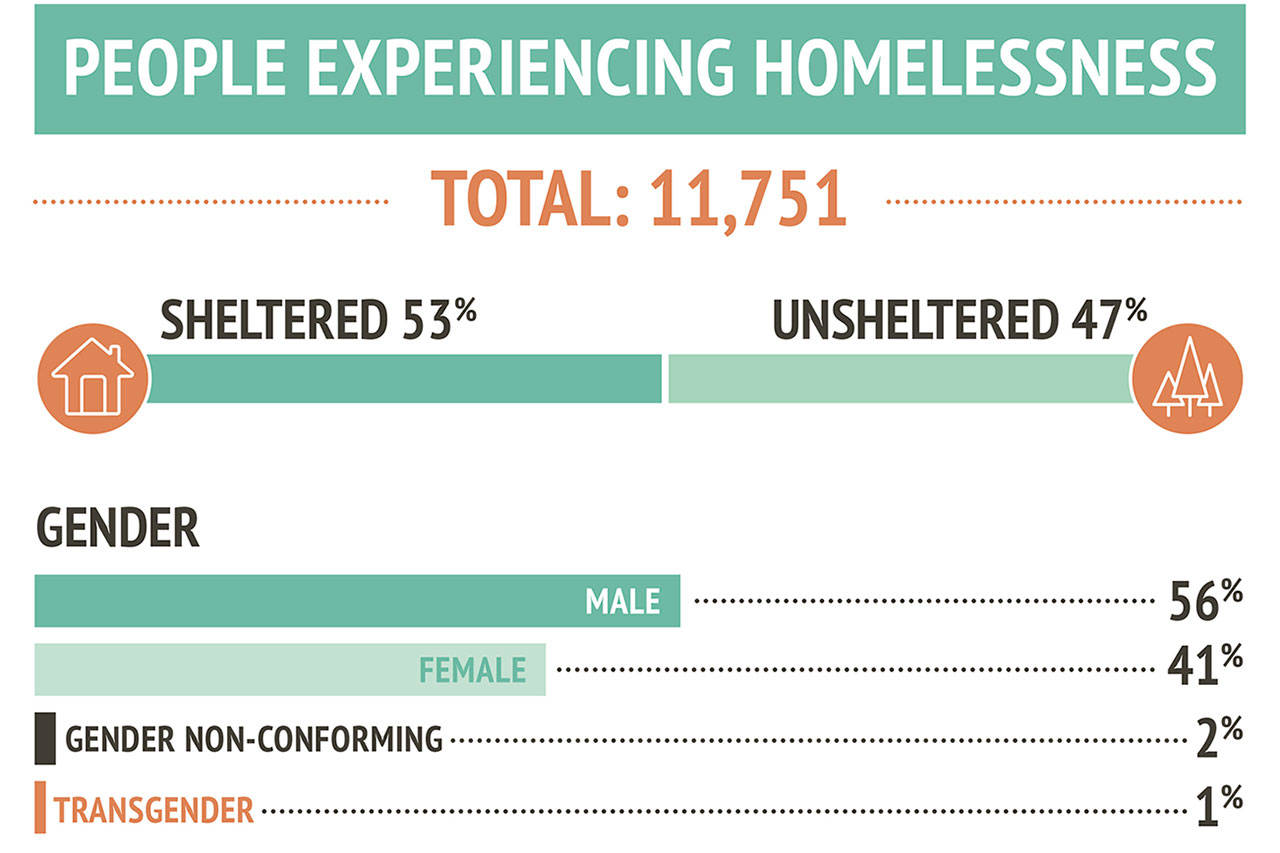A recent report shows homelessness in King County has increased by around 5 percent overall.
King County, through the Regional Homelessness Authority and the efforts of many volunteers, performs an annual Point In Time Count (also known as the Count Us In survey) to not only determine how many people are experiencing homelessness, but explore key demographics like age, race, mental health, veteran status, and the sexual identity and orientation of those who are currently unhoused.
The survey takes place every winter (this year, Jan. 24) and the report is released in the summer months.
The survey is only a glance at what homelessness looks like in King County, as the count only takes place over one night and is completely voluntary. Many factors, from the number of volunteers able to canvass the county to the newly-available Spanish survey, can affect the overall results. This year, the report noted there was “substantial rain” the night the survey was taken, and it “may have impacted the street count with decreased visibility from volunteers’ car windows and individuals experiencing homelessness, who were otherwise sleeping outdoors, may have taken cover from the weather during the hours of the count.”
Overall, volunteers counted 11,751 homeless individuals this year, a 5 percent increase from 2019. This year’s total doesn’t appear to be drastically different from past counts: 11,199 individuals were counted in 2019; 12,112 people in 2018, and 11,643 in 2017.
According to the count, approximately 53 percent of the people counted this year had some form of shelter, whereas the other 47 percent did not. These percentages are very similar to past counts.
However, it appears there seems to be a pattern of more people experiencing homelessness in emergency shelters. In 2017, volunteers counted 3,491 people in an emergency shelter, and the number has steadily grown every year to 4,085 in 2020.
There was also a dramatic rise in the number of people taking shelter in an abandoned building. From 2019 to 2019, less than 150 people were counted to be sheltering in an abandoned building, whereas this year, 662 people were counted. The report notes again that rainfall may have impacted this number, since the number of people experiencing homelessness and living on the streets or outside fell dramatically from 1,504 people in 2019 to 805 in 2020.
“The combined totals (of abandoned building count and street/outside count) are notably similar across the years,” the report reads.
It shouldn’t come as a surprise that most people experiencing homelessness — 72 percent in 2020 — in the county reside in Seattle. Volunteers noted only about 1 percent of the homeless population live down here in the southeast portion of the county — Black Diamond, Covington, Maple Valley, and Enumclaw — a number that has stayed constant for the last four years.
Compared to the county’s overall population, Black residents and people of color are disproportionally impacted by homelessness. While Black or African American individuals only make up 7 percent of the county’s total population, 25 percent of people experiencing homelessness this were identified as Black.
Additionally, while Native Americans or Indigenous residents make up only 1 percent of the total county population, they account for 15 percent of people experiencing homelessness this year.
Comparatively, while white people make up 67 percent of the county’s population, only 48 percent of the people counted this year were white.
Two trends that appear to be alarming are the increased number of families with children who are experiencing homelessness and the rising number of individuals who were experiencing homelessness due to domestic violence.
Between 2017 and 2019, the number of families with children counted for this report was steadily declining from 2,833 to 2,451. This year, however, the number of families counted increased to 3,743. The report notes that “this increase… can partially be attributed to concerted effort (sic) by agencies and service providers for families engaged in data collection efforts,” meaning there are simply more people being counted than before, not that there are more families experiencing homelessness overall.
The same can be said for the dramatic increase in the number of people experiencing homelessness due to domestic violence. In 2018, only 631 people were counted, and in 2019, 533. However, 1,211 people said they were homeless because they left an abusive situation this year.
As for reasons people report on why they’re experiencing homelessness (respondents pick all that apply), the most common is job loss, though the Count Us In report shows this is becoming a less common answer; about 30 percent of people counted in 2017 reported job loss as the reason they were experiencing homelessness, which has dropped to 16 percent in this year’s count.
Alcohol and drug use has also dropped from 20 percent in 2017 to 11 percent in 2020.
However, it appears those experiencing homelessness because they couldn’t afford a rent increase seems to be rising, moving from 6 percent in 2017 and 2018 to 8 percent in 2019 and 2020.
Others reasons for homelessness, like mental health issues, divorce and separation, and illness appear to be holding steady.
However, it appears that between 2017 and 2020, more people experiencing homelessness suffer from a psychiatric or emotional condition, from depression to schizophrenia, rising from 45 percent to 54 percent.
The number of people experiencing homelessness and having been diagnosed with PTSD or reporting abusing alcohol or drugs have also increased over the last four years.


